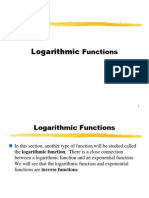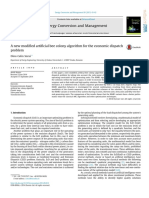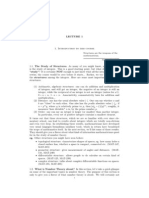0 ratings0% found this document useful (0 votes)
2 viewsLogarithmic Functions
The document provides an overview of logarithmic functions, including their definition, domain, and range, as well as properties and graphing techniques. It explains that logarithmic functions are the inverse of exponential functions and highlights their importance in mathematical calculations. Additionally, it includes examples and properties of logarithmic functions, along with methods for solving equations and real-life applications.
Uploaded by
rudyjr abaroCopyright
© © All Rights Reserved
Available Formats
Download as DOCX, PDF, TXT or read online on Scribd
0 ratings0% found this document useful (0 votes)
2 viewsLogarithmic Functions
The document provides an overview of logarithmic functions, including their definition, domain, and range, as well as properties and graphing techniques. It explains that logarithmic functions are the inverse of exponential functions and highlights their importance in mathematical calculations. Additionally, it includes examples and properties of logarithmic functions, along with methods for solving equations and real-life applications.
Uploaded by
rudyjr abaroCopyright
© © All Rights Reserved
Available Formats
Download as DOCX, PDF, TXT or read online on Scribd
You are on page 1/ 4
Logarithmic Functions
The logarithmic function is an important medium of math calculations. Logarithms
were discovered in the 16th century by John Napier a Scottish mathematician, scientist,
and astronomer.
The basic logarithmic function is of the form f(x) = log ax (r) or y = logax, where a >
0. It is the inverse of the exponential function a y = x. Log functions include natural
logarithm (ln) or common logarithm (log). Here are some examples of logarithmic
functions:
f(x) = ln (x - 2)
g(x) = log2 (x + 5) – 2
h(x) = 2 log x, etc.
Finding the value of x in the exponential expressions 2 x = 8, 2x = 16 is easy, but
finding the value of x in 2 x = 10 is difficult. Here we can use log functions to transform 2 x
= 10 into logarithmic form as log210 = x and then find the value of x.
Domain and Range of Log Functions
Let us consider the basic (parent) common logarithmic function f(x) = log x (or y =
log x). We know that log x is defined only when x > 0 (try finding log 0, log (-1), log (-
2), etc using your calculator. You will come up with an error). So, the domain is the set
of all positive real numbers. Now, we will observe some of the y-values (outputs) of
the function for different x-values (inputs).
When x = 1, y = log 1 = 0
When x = 2, y = log 2 = 0.3010
When x = 0.2, y = -0.6990
When x = 0.01, y = -2, etc
We can see that y can be either a positive or negative real number (or) it can be zero as
well. Thus, y can take the value of any real number. Hence, the range of a logarithmic function is
the set of all real numbers. Thus:
The domain of log function y = log x is x > 0 (or) (0, ∞).
The range of any log function is the set of all real numbers (R)
Example: Find the domain and range of the logarithmic function f(x) = 2 log (2x - 4) + 5.
Solution:
For finding domain, set the argument of the function greater than 0 and solve for x.
2x - 4 > 0
2x > 4
x>2
Thus, domain = (2, ∞).
As we have seen earlier, the range of any log function is R. So, the range of f(x) is R.
Logarithmic Graph
We have already seen that the domain of the basic logarithmic function y = log a x
is the set of positive real numbers and the range is the set of all real numbers. We know
that the exponential and log functions are inverses of each other and hence their graphs
are symmetric with respect to the line y = x. Also, note that y = 0 when x = 1 as y =
loga1 = 0 for any 'a'. Thus, all such functions have an x-intercept of (1, 0). A
logarithmic function doesn't have a y-intercept as loga0 is not defined.
Summarizing all these, the graphs of exponential functions and logarithmic graph look
like below.
Properties of Logarithmic Graph
a > 0 and a ≠ 1
The logarithmic graph increases when a > 1, and decreases when 0 < a < 1.
The domain is obtained by setting the argument of the function greater than 0.
The range is the set of all real numbers.
Graphing Logarithmic Functions
Before drawing a log function graph, just have an idea of whether you get an increasing
curve or decreasing curve as the answer. If the base > 1, then the curve is increasing; and if 0 <
base < 1, then the curve is decreasing. Here are the steps for graphing logarithmic functions:
Find the domain and range.
Find the vertical asymptote by setting the argument equal to 0. Note that a log function
doesn't have any horizontal asymptote.
Substitute some value of x that makes the argument equal to 1 and use the property
loga 1 = 0. This gives us the x-intercept.
Substitute some value of x that makes the argument equal to the base and use the
property loga a = 1. This would give us a point on the graph.
Join the two points (from the last two steps) and extend the curve on both sides with
respect to the vertical asymptote.
Example: Graph the logarithmic function f(x) = 2 log 3 (x + 1).
Solution:
Here, the base is 3 > 1. So the curve would be increasing.
For domain: x + 1 > 0 ⇒ x > -1. So domain = (-1, ∞).
Range = R.
Vertical asymptote is x = -1.
At x = 0, y = 2 log3 (0 + 1) = 2 log3 1 = 2 (0) = 0
At x = 2, y = 2 log3 (2 + 1)= 2 log3 3 = 2 (1) = 2
Properties of Logarithmic Functions
log ab = log a + log b
loga/b = log a - log b
logba = (logc a)/(logc b) (change of base rule)
logax = x loga
loga 1 = 0
loga a = 1
Examples: Solve each equation
1) log 5x = log (2x + 9)
2) log (−2a + 9) = log (7 − 4a)
3) 2log 7−2r = 0
4) −2log 5 7x = 2
5) −6log 3 (x − 3) = −24
6) log 12 (v 2 + 35) = log 12 (−12v − 1)
7) log x + log 8 = 2
8) log x − log 2 = 1
9) log x + log 7 = log 37
10) ln 2 − ln (3x + 2) = 1
Solving Real-Life Problems Involving Logarithmic Functions, Equations and
Inequalities
You might also like
- exponentialandlogarithmicfunctions-140306230640-phpapp01No ratings yetexponentialandlogarithmicfunctions-140306230640-phpapp0129 pages
- Math Assignment Unit 5 - MATH 1201-01 - AY2025-T2No ratings yetMath Assignment Unit 5 - MATH 1201-01 - AY2025-T212 pages
- Exponential and Logarithms (To Replace Sections 7.2-7.5) : Alfonso Gracia-Saz, MAT 137No ratings yetExponential and Logarithms (To Replace Sections 7.2-7.5) : Alfonso Gracia-Saz, MAT 1376 pages
- CHAPTER 2 - Exponential & Logarithmic FunctionNo ratings yetCHAPTER 2 - Exponential & Logarithmic Function29 pages
- GEN-MATH-Q1-Mod8-Log-Fn-Graph-Word-ProblemsNo ratings yetGEN-MATH-Q1-Mod8-Log-Fn-Graph-Word-Problems16 pages
- Chapter 2 Functions of Real Variables 2020 2021No ratings yetChapter 2 Functions of Real Variables 2020 202148 pages
- 6.2 Properties of Logarithms: A B X Log (X)No ratings yet6.2 Properties of Logarithms: A B X Log (X)22 pages
- PANINI DCC1 06 May 2019 11 May 2019 For WebsiteNo ratings yetPANINI DCC1 06 May 2019 11 May 2019 For Website22 pages
- MATH 31B - Week 1 Exponential, Inverse Functions, and Logarithmic Functions (I)No ratings yetMATH 31B - Week 1 Exponential, Inverse Functions, and Logarithmic Functions (I)3 pages
- Global Max and Min For Two Variables Functions: 1 References To The Case of One VariableNo ratings yetGlobal Max and Min For Two Variables Functions: 1 References To The Case of One Variable7 pages
- Logarithmic Functions: What This Module Is AboutNo ratings yetLogarithmic Functions: What This Module Is About26 pages
- Daniel Wahba - Optional Logarithmic AssigmentNo ratings yetDaniel Wahba - Optional Logarithmic Assigment6 pages
- There Are Some Laws of Indices Which Are As FollowsNo ratings yetThere Are Some Laws of Indices Which Are As Follows50 pages
- Math 152, Section 55 (Vipul Naik) : X 1 R X 0 XNo ratings yetMath 152, Section 55 (Vipul Naik) : X 1 R X 0 X12 pages
- Finding the Inverse of an Exponential or Logarithmic FunctionNo ratings yetFinding the Inverse of an Exponential or Logarithmic Function11 pages
- What Is A Function? How To Describe A Function Domain and RangeNo ratings yetWhat Is A Function? How To Describe A Function Domain and Range5 pages
- GTM200-An Introduction To Riemann-Finsler Geometry2000No ratings yetGTM200-An Introduction To Riemann-Finsler Geometry2000453 pages
- A New Modified Artificial Bee Colony Algorithm For The Economic Dispatch ProblemNo ratings yetA New Modified Artificial Bee Colony Algorithm For The Economic Dispatch Problem20 pages
- Lecture 1 Introduction To Number Theory, MAT115A100% (1)Lecture 1 Introduction To Number Theory, MAT115A6 pages
- Configuration Form : System Model RepresentationNo ratings yetConfiguration Form : System Model Representation2 pages
- AIATS First Step (CoE XI) JEE (Main & Advanced) - 2024-25No ratings yetAIATS First Step (CoE XI) JEE (Main & Advanced) - 2024-251 page
- Solving Algebra Equations With FractionsNo ratings yetSolving Algebra Equations With Fractions2 pages
- exponentialandlogarithmicfunctions-140306230640-phpapp01exponentialandlogarithmicfunctions-140306230640-phpapp01
- Exponential and Logarithms (To Replace Sections 7.2-7.5) : Alfonso Gracia-Saz, MAT 137Exponential and Logarithms (To Replace Sections 7.2-7.5) : Alfonso Gracia-Saz, MAT 137
- MATH 31B - Week 1 Exponential, Inverse Functions, and Logarithmic Functions (I)MATH 31B - Week 1 Exponential, Inverse Functions, and Logarithmic Functions (I)
- Global Max and Min For Two Variables Functions: 1 References To The Case of One VariableGlobal Max and Min For Two Variables Functions: 1 References To The Case of One Variable
- There Are Some Laws of Indices Which Are As FollowsThere Are Some Laws of Indices Which Are As Follows
- Finding the Inverse of an Exponential or Logarithmic FunctionFinding the Inverse of an Exponential or Logarithmic Function
- What Is A Function? How To Describe A Function Domain and RangeWhat Is A Function? How To Describe A Function Domain and Range
- GTM200-An Introduction To Riemann-Finsler Geometry2000GTM200-An Introduction To Riemann-Finsler Geometry2000
- A New Modified Artificial Bee Colony Algorithm For The Economic Dispatch ProblemA New Modified Artificial Bee Colony Algorithm For The Economic Dispatch Problem
- AIATS First Step (CoE XI) JEE (Main & Advanced) - 2024-25AIATS First Step (CoE XI) JEE (Main & Advanced) - 2024-25



































































































